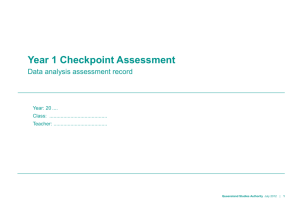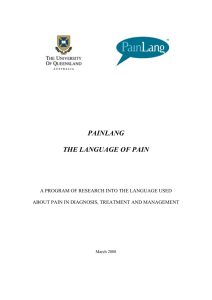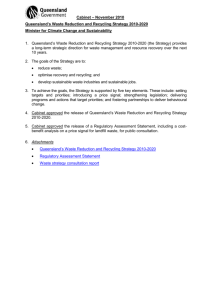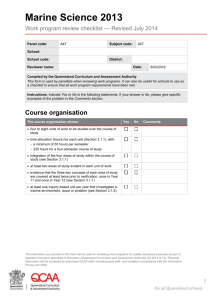resource - Queensland Government
advertisement
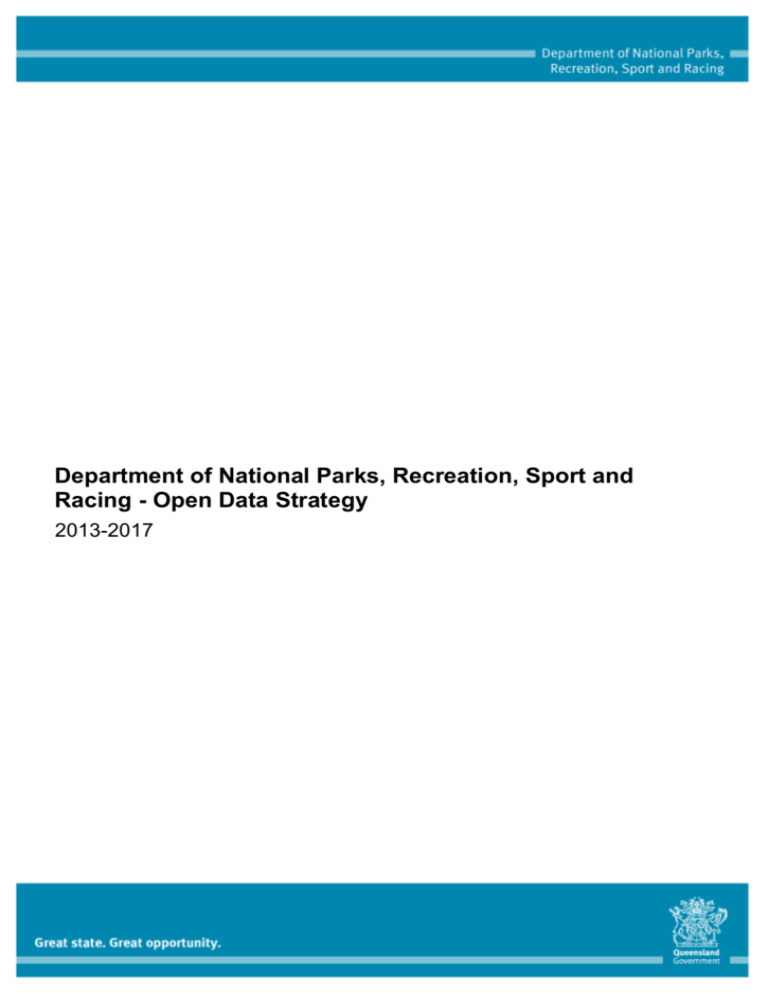
Department of National Parks, Recreation, Sport and Racing - Open Data Strategy 2013-2017 Scope This document defines the department’s strategies and subsequent timeframes for meeting the government’s Open Data Initiative including the definition, approval, publishing and management of departmental data sets to support the Open Data Portal – www.qld.gov.au/data Strategy statement In line with the Queensland Government’s Open Data Initiative, the department will contribute to the continued growth of the State’s tourism, protected areas, recreation, sporting and racing activities through the delivery of data sets to the Open Data Portal (www.qld.gov.au/data) in a timely and managed manner and in formats that meet the contemporary needs of our customers. Purpose The purpose of this document is to articulate a roadmap to allow the department to deliver data sets to the public, free to anyone who wishes to use it. Goals Better services for Queenslanders through innovation, research and development of new data-enabled services and products by researchers, business and industry using Government data. Increased community participation in government decision making through improved access to Government data and greater levels of interaction between policy-makers and the wider community. A stronger knowledge economy by unlocking the social and economic value of Government data through sound data infrastructure. Evolving data sophistication and functionality through ongoing engagement with data users and perpetual review. Our data We collect, store and maintain a diverse range of datasets to support the delivery of protected area management, recreation, sport and racing policy services to the community. These datasets can be grouped into the following main categories: National parks Protected areas Marine parks Sport Recreation Racing 2 of 9 Background On 9 October 2012, the Premier announced an ‘open data revolution’ for the Queensland Government with the aim of releasing as much government data as possible to encourage the private sector to develop innovative new services and solutions for the State. An Assistant Minister to the Premier on e-government was appointed to work alongside the Minister for Science, Information Technology, Innovation and the Arts to drive the initiative. Principles of the Open Data Portal The rapidly emerging digitally-rich environment provides opportunities to: improve services to the community inform government decision making contribute to the economic development of Queensland assist in making the Queensland public service more customer-focused. The portal in its initial implementation is not primarily focussed on delivering dynamic (real time or near real time) data as has traditionally been delivered via departmental web sites (for example, Get in the Game sports vouchers). The purpose of the portal is to increase transparency and accountability through increasing availability to government data sets and drive innovation through providing easy access to government data. Information delivered through the portal will be provided in machine readable formats (such as CSV, XML, KML, Shape Files etc.) for re-use by third parties undertaking application development or data analysis. Governance The Director-General, Department of National Parks, Recreation, Sport and Racing is responsible for the success of the department’s Open Data initiative by creating and sustaining an open data culture within the department. Execution of our Open Data Strategy will be governed by the department’s Executive Management Team, sponsored by the Deputy Director-General, Corporate Services. Progress against the success criteria of the initiative will be reported in the Queensland Government rolling six month action plan to be prepared by the Department of the Premier and Cabinet and overseen by the whole of government Open Data Reform Group (CEO Leadership Team). This strategy is a four year forward plan to be reviewed annually. The department will also provide a quarterly progress report to the Open Data Reform Group. Key Considerations Definition of data For the purpose of the Open Data Portal, data is described as: Machine readable data such as: o CSV – Comma Separated Values o XLS – Microsoft Excel Spread sheet o XML – eXtensible Markup Language o RDF – Resource Description Framework, modelling information o KML/KMZ – Keyhole markup language, suitable for viewing in Google Earth, Google Maps or other supported applications o Shapefiles – ESRI shapefile overlays (spatial data) Data is NOT PDF files, Annual Reports, Briefs etc. The identification of data sets for release and ongoing management of data The department has identified and published an initial grouping of data sets in line with this initiative, http://www.nprsr.qld.gov.au/data-sets/index.html as well as including a ‘Data sets’ area to the home page of the departmental internet site. A data set identification process was undertaken within the department and the data identified for inclusion in the portal is included as Attachment A. 3 of 9 Accessibility and release standards The Queensland Government Enterprise Architecture (QGEA) information principles define the standards by which the Queensland Government manages and releases information, and these principles apply directly to the open data initiative: Transparent - The public has a right to information. Trustworthy - Information is accurate, relevant, timely, available and secure. Private - Personal information is protected in accordance with the law. Equitable - Information is accessible to all. Valued - Information is a core strategic asset. Managed -Information is actively planned, managed and compliant. AusGOAL1 Principles suggest that data be made available in machine readable formats that can be read by freely available software and publication in more than one (open) format is recommended. The department supports these principles and this strategy will assist the department to move through the generations of maturity and deliver data in multiple formats (such as CSV, XML, SQL etc.) that best suit the type of data being delivered and meet the identified expectations of the users consuming the data. Licensing framework and intellectual property impacts The Queensland Government has an intellectual property framework in place governing the release of public sector information, which includes the Queensland Public Sector Intellectual Property Principles (version 2) (IP Principles) and an information licensing framework. The IP Principles recommend that all copyright public sector information should be released for free and open re-use and adaptation under a Creative Commons licence as a default position, unless there are specific reasons to restrict access. The department is moving toward providing all of its online content through appropriate Creative Commons Licensing. The default licence applied to content will be the CC-BY licence with other licences being applied to content that requires restrictions. This approach aligns with the delivery of departmental web content via the wholeof-government web franchises. Any data released to the Open Data Portal by the data custodian will have the relevant Creative Commons licence applied to it as part of the approval and public process. 1 AusGoal is the Australian Governments Open Access and Licensing Framework, provides support and guidance to government and related sectors to facilitate open access to publicly funded information. Confidentiality and personal privacy requirements Government holds substantial amounts of data about its citizens. Accordingly, the relationship between government and its citizens requires government to be a responsible custodian of its citizens’ data and not to unnecessarily expose that data. Privacy is one mechanism for satisfying these obligations. In addition Government holds other confidential information such as commercial-in-confidence and operational information. How to best manage confidentiality in light of an agenda to promote open data will need to be determined. Clearance by the department’s Privacy Unit group will form part of all approvals for data sets to be published. Legislative changes that may be required to facilitate and promote release of information Queensland Government legislation supports the proactive release of government information. The Right to Information Act 2009 (Qld) (the RTI Act) establishes, as a default position, the proactive release of government information into the public sphere, unless, on balance, the release of this information is determined to be contrary to the public interest, or it falls under legislative limitations to access, such as those in the Information Privacy Act 2009. As part of its terms of reference the internal Working Group for Open Data within NPRSR will identify any instances where this is likely to be an issue and escalate them to the responsible Deputy Director-General and/or Executive Management Team for consideration and decision as appropriate. 4 of 9 Strategy The following broad fundamental strategies outline how the department will implement the move to Open Data. These strategies will be supported by a set of Operational implementation processes to drive business change for the benefit of the people of Queensland as well as achieve best practice and generational maturity for the department’s data sets. Fundamental strategies The department will: Adopt a default position of making all relevant data held by the department available to the public of Queensland through the Open Data Portal Undertake appropriate business transformation processes to enable the delivery of relevant data sets to the Open Data Portal Consider the value of data to the people of Queensland and strive to be a leader in delivery of data Operational implementation: The department will: Consider data in any and all online publishing activities as they occur Adopt an approach of enabling automated publishing of data sets to the Open Data Portal for any data that is used in delivering NPRSR online content. Web Services will: Lead the process and serve as evangelists for data availability in their dealings with business areas of the department Lead the process to re-engineer data to be available to the Open Data Portal as part of the whole-ofgovernment web franchise implementation, Release strategy Our release strategy contains four main components: Identification: We will proactively identify information assets by surveying departmental publications and business systems for underlying data sources, gathering information from business units about stand-alone data collections and engaging with stakeholders about their needs and interests. Assessment: We will assess the suitability of data for release in accordance with relevant legislation, administrative instruments, policies and guidelines. The release of data will be prioritised according to its value to the public, such as allowing new products or services to be developed, increasing openness and transparency of government and its processes, and use by researchers or non-government organisations. Not all data are suitable for release. The process of identifying and assessing data for publication acknowledges the need for it to be accessible to external audiences. Datasets subject to valid privacy, security or privilege limitations may be restricted or released in a modified form. Publication: We will publish data in line with set standards and prioritised having regard to public interest; feedback from stakeholders; potential social or economic value; and ability to restore accountability in government, with the approval of the data owner. Management: We will maintain datasets as fit-for-purpose, identify opportunities to improve data quality, seek feedback from data users and review our processes to ensure maximum efficiency. Timelines This strategic plan for Open Data within NPRSR will look to meet the timeframes for maturity by moving from the current 2nd Generation to 3rd Generation by December 2014, with further maturity to 4th Generation by December 2015 and 5th Generation by July 2017. The data delivered through the portal may be post event data but it is still likely to be in the public interest. Examples of this could be the number of camping visitors across the state within a particular timeframe. 5 of 9 Licensing approach Government data will be available for open use: Open access to Government data drives innovation and entrepreneurial activities. Where appropriate, data will be made available under the least restrictive licence allowing for its use and re-use in accordance with the Australian Government Open Licensing framework. Publishing process The department will continue to be responsible for the publishing and hosting of its data sets with the portal providing relevant metadata about the data set and a link to the data. TeamSite (the department’s web content management system) will be used to publish all data sets to the NPRSR web site. A customised data workflow will be used to achieve this publishing. The workflow will ensure recording of all approvals to publish and also ensure that the department meets it requirements in relation to recordkeeping. 6 of 9 Attachment A – NPRSR data sets identified for immediate release The table below contains a list (as at time of publication) of data owned by the department to be published to the Open Data Portal, additional data sets will be published to the Open Data Portal over time as they are created or become available. Data set Description Custodian Format Great Barrier Reef Marine Park Zoning Zonings within Queensland State Marine Park - Great Barrier Reef Coast Marine Park. DDG, Queensland Parks and Wildlife Service ESRI shape file / csv Moreton Bay designated areas This dataset represents the designated areas from the Marine Parks (Moreton Bay) Zoning Plan 2008 (which comes into effect 1 March 2009). DDG, Queensland Parks and Wildlife Service ESRI shape file / csv Moreton Bay habitat model This data set represents the habitat models within Moreton Bay. DDG, Queensland Parks and Wildlife Service ESRI shape file / csv Moreton Marine Park bay zoning 2008 This dataset represents the zoning from the Marine Parks (Moreton Bay) Zoning Plan 2008 (which comes into effect 1 March 2009). DDG, Queensland Parks and Wildlife Service ESRI shape file / csv Park Management Plans Approved plans documenting how protected areas will be managed in the long term DDG, Queensland Parks and Wildlife Service PDF QPWS bioregional fire vegetation groupings The fire vegetation groups and fire regime groups are derived from a reclassification of the Regional Ecosystems (RE) data for the purpose of practical fire management. DDG, Queensland Parks and Wildlife Service ESRI shape file / csv QPWS Regional boundaries Boundaries delineating Queensland Parks and Wildlife Service administrative regions DDG, Queensland Parks and Wildlife Service ESRI shape file / csv State Marine Parks - QLD Zonings within Queensland State Marine Parks DDG, Queensland Parks and Wildlife Service ESRI shape file / csv Research Undertaken by the Centre of Excellence for Applied Sport Science Research List of research projects undertaken by the Centre of Excellence for Applied sport Science Research Executive Director QAS CSV RSC produced scientific paper and posters List of scientific paper and posters. Executive Director, Office of Racing CSV 7 of 9 Attachment B – Dataset approval process workflow Attachment C – Web publishing approval workflow


